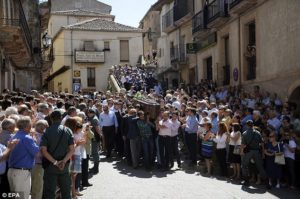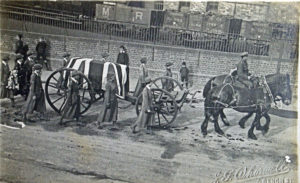Different countries have different funeral traditions. The Spanish funeral focuses, among other things, on a rapid burial or interment.

Credit: dailymail.co.uk
Many deaths in Spain occur in the home. The sick person’s loved ones usually start to prepare for the death a few weeks or a few days before it’s expected to occur. The first step is offering communion or last rights to the dying person.
When death takes place, the family calls the local police, or “Policia Local.” The police or the family then contacts the dead person’s physician. The family then chooses the funeral director, sometimes with the assistance of the police.
The funeral director takes over and makes all the arrangements so that the family will not need to undergo any additional stress. Autopsies only occur when the cause of death is unclear.
The funeral director then arranges the transfer of the body to the “tanatorio“ or “chapel of rest.” The funeral director, family or police register the death within 24 hours at the civil agency. Interment or burial generally takes place within 24 hours as well, and no more than 48 hours after death.
The loved ones of the person who has died usually learn of the death by word of mouth, rather than reading an obituary. Because the funeral occurs so quickly after death, an obituary usually doesn’t have time to run before the burial.
After the body reaches the “tanatorio,” it is typically placed in a coffin behind a glass casing. Curtains are available for those who do not want to view their loved one.
Members of the family stay with the body until the funeral. Sometimes only one person, such as a spouse or a friend, sits vigil. Other times several people who were close to the person who died sit together or take turns.

Credit: doverhistorian.files.wordpress.com
The body is then moved from the chapel of rest to the cemetery when it is time for the funeral. Family and well-wishers often walk behind the casket as a sign of respect.
Cremation is not common during Spanish funerals. The usual method of disposition is interment in an above ground family niche. Families rent these niches for a set period of time. When that time expires, the body is moved to a common burial ground unless there are family members who wish to rent the niche again.
Dress for a visitation generally consists of dark colors and an outfit that is not overly formal, flashy or showy. After the funeral, the families have two choices. Some Spanish funerals hold wakes with drinks and story-telling. Other families find these wakes offensive and prefer to return home directly after the funeral.
Nine days after the death, the family holds a ceremony known as a “rosario.” It consists of candles, flowers, prayers and sharing memories of the person who has died. The rosario also takes place every year on the anniversary of the person’s death.

 The Tradition of the Spanish Funeral
The Tradition of the Spanish Funeral


 First the Wealth Gap, Now the U.S. Has a Growing Health Gap
First the Wealth Gap, Now the U.S. Has a Growing Health Gap
 How to Comfort A Dying Loved One
How to Comfort A Dying Loved One
 Our Annual Seven Holiday Gifts for Someone Who Is Grieving, 2024 Edition
Our Annual Seven Holiday Gifts for Someone Who Is Grieving, 2024 Edition














